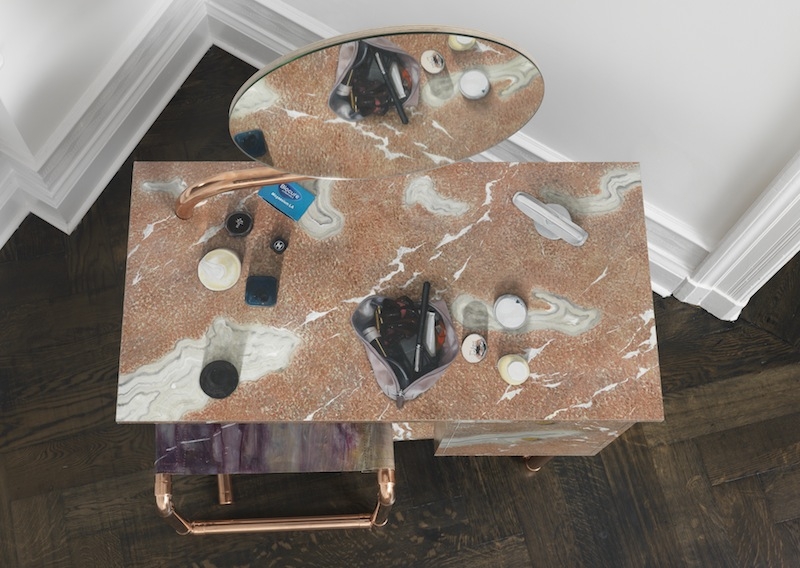Charlottenburg, in West Berlin, has under- gone a makeover that aims to rejuvenate its moribund shopping thoroughfare, the Kurfürstendamm, and its sleepy memories of Weimar-era dynamism. There are nightspots named for a once-glorious past (the Grosz Restaurant, the Lang Bar); nearby on upmarket Fasanenstrasse, meanwhile, Lucy McKenzie has revamped the interior of a Wilhelmine apartment on the second floor of Galerie Buchholz. The Glasgwegian artist’s penchant for trompe l’oeil renderings features strongly here: there is much faux wood, imitation-marble surfacing and other illusionist trickery. McKenzie acquired her proficiency in these techniques at an artisanal school in Brussels where white work-coats and a deferential attitude to patrons are reputedly the norm. The spaces she simulates here belong to the world of business leaders, a zone of capitalist reality.
The first room is an office of sorts, with paintings of pinboards from McKenzie’s Quodlibet series (all works 2015) featuring tax returns and business-account credit-card correspondence from the Royal Bank of Scotland. Other memos congratulate the absent owner on their recent appointment as a company director. In the corridor/waiting room a table is covered with painted French interior design magazines; elsewhere an impressively large painting details a map of Holland, its cities and their coats of arms highlighted. The sun is depicted shining its beneficent rays over the territory; a goddess extends her hand over the lucky homeland.
Then there is a sparsely furnished, cell-like spare bedroom for the maid with a portrait of the Virgin Mary looking down on a stripped and striped mattress. The main office-space features a mighty faux-marble desk on which sit two flat painted items, a cup of coffee and an iPhone. There’s an actual lamp in the shape of a seashell that recalls Victor Horta’s stylings. On the wall is another large canvas, this time illustrating the Dutch East Indies, the colonised lands, with a sailor staring out at the conquered treasure, a cannon at his feet. Is this an oil company office belonging to Shell, perhaps? Maybe I’m imagining a briny tang of Conradian skullduggery…
The main bedroom features another eye-tricking gimmick, a lilac-coloured makeup bag, opened up like a mussel that includes a mascara stick below a real mirror. Two comically dull abstracts line the walls of this corporate hell. The bathroom is rendered as one large canvas, an Oskar Schlemmer-like linearity conveying some stairs. Later I peer behind
a closed door and discover a real bathroom: the materiality of its white tiles momentarily shocks. Quite what all this has to do with leprosy, as per the title, is not immediately apparent; perhaps the transactions imagined here are unclean. Maybe with those maps in mind we are meant to think of Indonesia today, where there are an estimated 16,000 new cases a year, a forgotten side-effect of Western rapacity.
McKenzie’s rooms have none of the spooky menace or implied horror of Mike Nelson’s or Gregor Schneider’s. Instead there is an autistic delight in perfection of execution, in technique, the handmade, that dares to be labelled as regressive, even conservative. But the ambiguity of what we see extends to its meaning. Lapidary verities are not to be trusted. It is not clear what has ‘inspired’ this work, and there is the lingering suspicion that our legs are being ever so gently pulled. Speaking of legs: be careful of the carpet at the top of the stairs as you leave; it is ripped and ready to trip you up. And it is not a painting. McKenzie’s revivalist style here, as with the cosmetic remaking of West Berlin, is a coy, risky affair, not so much mock-rock then as mock bloc.
20 November 2015 – 23 January 2016, Galerie Buchholz, Berlin
This article was first published in the January & February 2016 issue of ArtReview.
